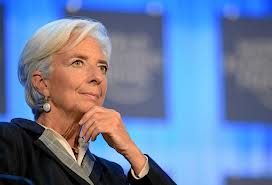Global Interconnections and Spillovers
Extracts from a Speech By Christine Lagarde, Managing Director, International Monetary Fund
U.S. Chamber of Commerce, September 19, 2013
I. The Global Economy Today

Christine Lagarde
I recently returned from the G-20 Summit in St. Petersburg—where I know that the Chamber was represented as well. So, let me begin there.
Going into the Summit, some were anticipating a strong difference of views between the advanced and emerging economies about the gradual withdrawal—or ‘tapering’—of unconventional monetary policy in the U.S. and its potential spillover effects for other nations. Instead, countries had constructive discussions. G20 members recognized the need to ensure that exit from this exceptional monetary support, when it comes, should be orderly and clearly communicated. There was also a clear recognition that the emerging market economies, for their part, need to address their domestic challenges to manage any spillovers effectively.
I also had the opportunity in St. Petersburg to meet with business and labor leaders—the B20 and L20. Their consecutive presentations at a joint meeting with heads of state underlined the importance of business, labor and government working together to secure sustainable and inclusive growth.
“G20 members recognized the need to ensure that exit from this exceptional monetary support, when it comes, should be orderly and clearly communicated.”
The Summit took place in the context of a challenging—and changing—global economic environment. The IMF will release its updated forecasts in a few weeks. For now, let me say that while we are seeing some signs of recovery, global growth remains subdued.
However, the story is more complex than that. More and more economies are moving at different speeds. We also know that the fruits of growth are far from being shared widely—this is true for the U.S. and for many other countries.
Certainly, the advanced economies are in a better place than they were six months ago. We see that with growth picking up here in the United States—a point I will come back to a bit later. For the first time in a long time, the Euro Area is also beginning to grow, although there is still much to be done. And while Japan’s reform efforts are ongoing, it is also doing better thanks to aggressive policy support.
Emerging market countries are the other side of the story. In large part, they helped keep the global economy afloat during the crisis. Now, while still dynamic, their momentum is slowing. For some, this may be a shift toward more balanced and sustainable growth. For others, it reflects the need to address imbalances that have made them more vulnerable to the recent market turbulence.
We all talk about global interconnections and spillovers. I certainly came to appreciate this as Trade Secretary for France. What has struck me most since coming to the IMF is their size and significance.
Some examples: since 1980, the volume of world trade has increased fivefold. And trade has grown in importance for global production. World exports relative to output grew from 20 percent in 1995 to 30 percent in 2008, before falling during the Great Recession, and recovering somewhat since.
There has also been the rapid acceleration of financial integration. By the time of the crisis, global capital flows were more than triple their level in 1995.
The IMF’s recent ‘spillover’ analysis—how what happens in one country affects others—reinforces the importance of this interconnectedness. It suggests, for example, that if the world’s five major economies were to work together to adopt a more rigorous, comprehensive and compatible set of policies, it would increase global GDP by about 3 percent over the longer run.
We all have a large stake in these interconnections. What happens elsewhere in the world—be it the success of recovery in Europe or the continued smooth functioning of supply chains in Asia—matters increasingly for the United States. The converse is also true. What happens here matters increasingly for the global economy.
II. The Role of the United States in the Global Economy
This brings me to my second main theme: the critical role of the United States, and American business in particular, in our increasingly interconnected world.
The recovery gaining strength here is good news for America—and good news for the world. Admittedly, U.S. growth will be more modest this year than we would want—still well below 2 percent. Even so, it should accelerate significantly next year, by about one percentage point.
Indeed, the fundamentals of the U.S. economy have been improving gradually. Households are in better shape—they have lowered their debt and benefited from the recovery in house prices and the strong performance of the stock market. The housing sector is looking brighter, with ample potential for construction activity to pick up further. The private sector is yet again proving to be the primary engine of growth and job creation—and the main reason for weak growth this year is the very large ongoing fiscal adjustment, a theme I will return to shortly.
Job creation is the key ingredient of any economic recovery, domestic or global. The latest U.S. jobs data present a mixed picture. The unemployment rate has declined to 7.3 percent in August, but the participation rate has continued to decline, and employment remains well below pre-crisis levels. So the issue of jobs remains paramount.
Jobs and growth is an increasingly important component of the IMF’s policy advice. I know that it is very much on your minds here at the Chamber too.
Business—including the people in this room—have a key role to play. At the same time, policymakers also have an important responsibility to help shape the environment in which businesses and citizens can thrive—and jobs can be created.
So what should U.S. policymakers do? Here are a few points from our most recent assessment of the U.S. economy in July:
First, fix public finances. I have characterized this as a case of “slow down, but hurry up.” While we think it would have been more advisable to have a slower pace of fiscal consolidation in the short run—without using the blunt instrument of sequester—more action is needed to reduce long-run pressure on the budget. This includes addressing entitlement spending and higher revenues. In addition, the ongoing political uncertainty over the budget and the debt ceiling does not help. It is essential to resolve this—and the earlier the better—for confidence, for markets, and for the real economy.
Second, appropriately calibrated monetary policy, our advice is that exit from unconventional monetary policies should be gradual, linked to progress in the recovery and employment, and that it should be clearly communicated and in a dialogue.
Third, finish reforming the financial sector. There has been progress on this agenda— for example, the new capital and liquidity requirements for banks under Basle III—but the system is still not safe enough. Policymakers need to turn their attention to the outstanding danger zones, especially derivatives and shadow banking. The ultimate goal is clear: to have a financial system that is less prone to instability and better able to serve the real economy.
Financial sector reform, of course, is not the sole responsibility of the United States. It needs to be tackled in many countries and regions, ideally in a coordinated and consistent way to ensure the healthy function of the entire global financial system. I am thinking here for instance of the resolution of international financial institutions.
This brings me back to the point of global connections.
The United States plays a unique role in the global economy. I am thinking, for instance, of global trade—of which the U.S. accounts for 11 percent. The U.S. also represents 20 percent of global manufacturing value-added. I know that you recognize the potential of an even bigger market. Tom and others at the Chamber have often referred to 95 percent of your potential customers living “outside the U.S.”
America’s global financial ties are even deeper. Foreign banks hold about $5½ trillion of U.S. assets, while American banks hold about $3 trillion of foreign claims. Meanwhile, close to half of the S&P500’s sales originate from foreign operations.
These interconnections have great benefits for the United States. But they are not without risks—two-way risks—and we saw some of these play out during this crisis.
We all remember, five years ago, how the collapse of one U.S. bank ushered in a harsh new reality across sectors, across countries, and across the world. As those tensions traveled across the Atlantic, for example, they exposed tensions in Europe.
Considering that 20 percent of U.S. exports are destined for Europe, and that more than half of U.S. overseas assets are held in Europe, you clearly have a large stake in the recovery there.
And yet, despite the risks, I know that you are also deeply aware of how much can be gained from engaging with the rest of the world.
President Taft, who helped establish the Chamber, captured this when he said: “I am in favor of helping the prosperity of all countries because, when we are all prosperous, the trade with each becomes more valuable to the other.”
What was true in President Taft’s day is even more true in today’s interconnected world: a strong U.S. economy and a strong global economy are two sides of the same coin.
III. The Role of the IMF
This brings me to my final point: the role of the IMF in the global economy—and why an effective IMF is important for our global membership and for the United States.
Earlier I spoke of the broad goals that the IMF and the Chamber share. We have something else in common. In 1914, on the eve of World War One, the Chamber’s first president, Harry A. Wheeler, said: “This is a new day when our methods are being reorganized, and the organized forces of labor and of agriculture and of commerce meet here in Washington, not for war, but for peace…”.
In much the same way, the IMF was born from the ashes of the Great Depression and World War Two, and grounded in the principle of good global citizenship: if countries work together to serve our common interests, everybody wins.
The IMF’s founders—an Englishman, John Maynard Keynes, and an American, Harry Dexter White—had a plan. A vision of a global economic “club” where countries could cooperate with a clear objective: global economic and financial stability.
Like a credit union for the world, the IMF’s member countries pool resources that can provide a lifeline to members in need. In fact, the first country to draw on IMF assistance was my home country, France.
A couple of decades later, the IMF helped the newly independent countries during decolonization. When the Berlin Wall fell, the Fund supported Eastern Europe’s efforts to transform from centrally-planned economies into market economies. In between, the IMF has helped its members to overcome economic crises—in Latin America in the 1980s, Asia in the 1990s and, most recently, in the Eurozone.
These actions might seem far removed from what happens in your business or in your economy, but they have very real implications. Our policy advice, for example—including in core areas like exchange rates or external imbalances—has helped to prevent or to ease the hardship of crises around the world. That, in turn, has helped reduce the possible negative fallout for the U.S. and for all countries.
And as the needs of our member countries have changed over time, so too the IMF has refined, repurposed and restocked its toolkit.
During this crisis, this has included a significant increase in our financial support, with over $300 billion in loans in over 50 countries—not just in Europe, but also in many other parts of the world, including in Africa and other low-income nations. We also introduced more flexible types of support that act as insurance for crisis prevention and have helped countries like Colombia, Mexico, and Poland.
Above all, the IMF has given much greater emphasis to global interconnections in its analysis—in particular, economic spillovers between countries, and also the critically important financial sector. To be effective into the future, we must continue to evolve and anticipate what lies ahead.
In this context, the IMF is currently working toward a set of governance reforms that will strengthen further our capacity to prevent and resolve crises; and at the same time, will help broaden our representation to better reflect the changing dynamics of the global economy. These “quota” reforms need the support of all our member countries—including the United States.
You may have an interest in also reading…
World Economic Forum: Less Is More and Other Wisdom from Davos
Less is more, and you better get used to it. That is the message US real estate tycoon Jeff Greene
IMF: KSA Is One of The Top G-20 Performers
On July 08, 2013, the Executive Board of the International Monetary Fund (IMF) concluded the Article IV consultation with Saudi
IMF: Sri Lanka Has the Potential
On July 9, Anoop Singh, Director of the IMF’s Asia Pacific Department, delivered the keynote speech at the inauguration of



















































































